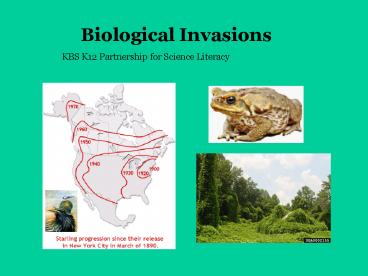Biological Invasions - PowerPoint PPT Presentation
1 / 23
Title:
Biological Invasions
Description:
Native species = a species that, other than as a result of an introduction, ... Japanese honeysuckle. Hydrilla. Chinese tallow tree. Nepalese browntop. Bamboo ... – PowerPoint PPT presentation
Number of Views:261
Avg rating:3.0/5.0
Title: Biological Invasions
1
Biological Invasions
KBS K12 Partnership for Science Literacy
2
Definitions from the National Invasive Species
Council Native species a species that,
other than as a result of an introduction,
historically occurred or currently occurs in an
ecosystem. Syn Indigenous Alien species
any species that is not native to an
ecosystem. Syn Non-native, non-indigenous,
exotic, immigrants, introduced Invasive
species an alien species whose introduction
does or is likely to cause economic or
environmental harm or harm to human health.
3
Exotic Species in Georgia
- The Weed that ate the South
4
(No Transcript)
5
(No Transcript)
6
(No Transcript)
7
(No Transcript)
8
Some characteristics of invaders High rate of
reproduction pioneer species Short generation
time Long-lived High dispersal rates Broad native
range Abundant in native range Tolerant of a wide
range of conditions Generalist
BUT even though we know a lot about invasive
species, we are still unable to predict which
non-native species will become invasive.
9
Why are people interested in invasive
species? The National Invasive Species Council
(NISC) was formed in 1999 to prevent the
introduction of invasive species and provide for
their control and to minimize the economic,
ecological, and human health impacts that
invasive species cause
10
Economic costs Estimates of total costs on
industry and agriculture range from 27 to 137
billion per year.
One estimate Zebra mussels caused losses of
60.2 million dollars to industries in the Great
Lakes between 1988 and 1994. (Approximately
800, 000/year for each power plant.)
11
Impact on native ecosystems Invasive species
impact 30-50 of the species currently listed as
Threatened or Endangered under the U.S Federal
Endangered Species Act. (Second only to habitat
destruction.)
12
Impact on human health
13
West Nile Virus in the United States as of
September 12, 2003
14
- Primary
- Productivity
Sunlight
Provides energy for
Creates organic matter that is transformed by
Are used for
Is carried out by
(2) Populations of organisms
(4) Nutrient and water cycles
Are used by
Create organic matter that is transformed by
Is carried out by
Are linked with
(3) Decomposition
- Disturbances change the flow of
- matter and energy through ecosystems
15
Impact on productivity and energy flow
Non-native earthworms can dramatically
increase decomposition in soils.
Non-native herbivores, like gypsy moth, directly
affect the flow of energy captured by plants from
the sun.
16
Impacts on populations and food webs
Sea Lampreys are native to the Atlantic Ocean,
but now impact fish in the Great Lakes.
Purple loosestrife becomes dominant in wet areas,
directly impacting other plant populations.
17
Impact on nutrient and water cycles
Invasive nitrogen fixers (like fayatree in
Hawaii) increase nitrogen in soils.
The high evapotranspiration rate of saltcedar
draws down the local water table and can slow the
flow of rivers and streams.
18
Impact on disturbances
Disturbances often promote invasion, but invaders
can change how frequently a disturbance occurs.
Forest
increased flammability
Savanna or grassland
microclimate change
land clearing
FIRE
grasses are favored by fire
introduction of non-native grasses
19
Methods of controlling invasive species 1)
Chemical control Ex., using pesticides 2)
Mechanical control Ex., physically removing the
invasive species 3) Biological control Ex.,
Introducing a natural enemy 4) Ecological
control Ex., Manipulating environmental factors
20
How to decide whether to control an invasive
species?
High Cost Low
Do nothing
??
Do nothing?
Control
Low Impact of invader
High
21
- What more is needed? (From Mack et al. 2000)
- Greater understanding of
- Movement of currently invasive species.
- Impact of invasive species on ecosystems.
- The likelihood that introduced species will
become invasive. - Experiments that allow us to understand 1.
- Better economic estimates of the true costs of
invasions. - Greater public and governmental awareness of the
effects of invasive species.
22
What you see in the video above represents a
24-hour observation of aircraft travel on the
earth's surface. Every dot of moving light
represents an aircraft carrying people and goods.
And, every dot represents potential for the
intentional or unintentional movement of plant or
animal species that may be travelling with those
people and their goods, species that could become
invasive once they establish in a new
environment.
23
Native to the western North Pacific Ocean, this
crab reached New Jersey in 1988, probably in ship
ballast water. Has now reached from Maine to
North Carolina. Carapace (body shell) is about
1.5 inches (35mm) across, squarish and mottled
green, purple or brown. Grows in intertidal zone,
hides under rocks, preys on native shellfish.
Clawed and considered aggressive. Could
displace existing crab population. May outcompete
lobsters, mussels and crabs. Report crab
sightings here. More information

